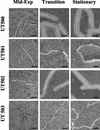Global effects of virulence gene regulators in a Bacillus anthracis strain with both virulence plasmids
- PMID: 12704148
- PMCID: PMC153248
- DOI: 10.1128/IAI.71.5.2736-2743.2003
Global effects of virulence gene regulators in a Bacillus anthracis strain with both virulence plasmids
Abstract
Control of anthrax toxin and capsule synthesis, the two major virulence factors of Bacillus anthracis, has been associated with two regulatory genes, atxA and acpA, located on virulence plasmids pXO1 and pXO2, respectively. We used transcriptional profiling to determine whether atxA and/or acpA control genes other than those already described and to investigate functional similarities of the regulators. Transcription was assessed in a pXO1(+) pXO2(+) parent strain and in isogenic mutants in which one or both regulatory genes were deleted. We determined that in addition to the toxin and capsule genes, atxA controls expression of numerous other genes on both plasmids and the chromosome. Generally, plasmid-encoded genes were more highly regulated than chromosomal genes, and both positive and negative effects were observed. Certain atxA-regulated genes were affected synergistically in an atxA acpA mutant. Yet overall, acpA appears to be a minor regulator with fewer targets than atxA. In contrast to previous reports of acpA function in attenuated strains, acpA had a minimal influence on capsule gene transcription and capsule synthesis in a genetically complete strain. Surprisingly, acpA expression was positively affected by atxA, although atxA-activated capsule gene transcription is not acpA dependent. The newly discovered atxA-regulated targets include genes predicted to encode secreted proteins and proteins with roles in transcriptional regulation and signaling. Regulation of chromosomal genes by atxA is particularly intriguing, given that many of the target genes have homologues in other Bacillus species that lack atxA homologues. Given the global effect of atxA on gene expression in B. anthracis, previous assumptions regarding reduced virulence of strains harboring single plasmids must be reassessed and the potential roles of newly identified atxA-regulated genes should be investigated.
Figures




References
-
- Agaisse, H., M. Gominet, O. A. Okstad, A. B. Kolsto, and D. Lereclus. 1999. PlcR is a pleiotropic regulator of extracellular virulence factor gene expression in Bacillus thuringiensis. Mol. Microbiol. 32:1043-1053. - PubMed
-
- Ash, C., J. A. Farrow, M. Dorsch, E. Stackebrandt, and M. D. Collins. 1991. Comparative analysis of Bacillus anthracis, Bacillus cereus, and related species on the basis of reverse transcriptase sequencing of 16S rRNA. Int. J. Syst. Bacteriol. 41:343-346. - PubMed
-
- Brennan, R. G., and B. W. Matthews. 1989. The helix-turn-helix DNA binding motif. J. Biol. Chem. 264:1903-1906. - PubMed
-
- Cataldi, A., E. Labruyere, and M. Mock. 1990. Construction and characterization of a protective antigen-deficient Bacillus anthracis strain. Mol. Microbiol. 4:1111-1117. - PubMed
Publication types
MeSH terms
Substances
Grants and funding
LinkOut - more resources
Full Text Sources
Other Literature Sources

